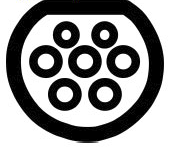EV Charging Guide
EV CHARGING GUIDE
Confused over Electric Vehicle Equipment Jargon?
Confused over Electric Vehicle Equipment Jargon?
Fear not, we have created a simple guide below to help us all understand the terms associated with electric vehicles. We hope it helps! Do get in touch if you need any advice or help to navigate this rather confusing tech.
Electricity terms
What do some of these terms mean when it comes to power for electric vehicles (EV's)?
DC: Stands for 'Direct Current' and means the direction of current travels in one direction through a conductor or cable. DC is an efficient form of energy transfer and is the best way to store energy in batteries. Your battery pack in your EV will be a DC battery.
If you use a charger classed as a 'fast charger' these are often transmitting power via DC. This way they can charge a battery very fast as the current travels in one direction directly to the battery. DC often needs thicker cables as it can provide a grunty current which creates heat.
AC: Stands for 'Alternating Current'. This means the current can travel in different directions through a cable or conductor at varying moments. This allows energy to be sent further through a cable as the resistance is reduced.
AC voltage can also be 'stepped down' via transformers to reduce the voltage for homes and appliances within them. All houses and buildings will have AC rated wiring. AC chargers are slightly slower than DC, however, they are far safer for domestic and most commercial use.
Phases: You will often hear the term 'single phase' or 'three phase' when it comes to wall mounted chargers.
Local electricity can be supplied in 1,2 or 3 lines into a building. If you have a typical residential home you will have one cable coming in from the power pole. This is called 'single phase'.
Commercial applications often require more energy, so these can have up to three cables coming in from the local grid. This is called 'three phase'.
Some EV (AC) chargers can charge faster from three phase supply. However, for most domestic needs this is overkill and it can be very expensive to convert a house to three phase.
Single phase should be all you need to charge a family EV or two.
Inverter: AKA Onboard charger. This is an energy converter (rectifier) that's inside your EV. It converts the AC electricity entering the car from the grid to DC so the energy can be stored in the battery (a little confusing, but stick with us!).
Your car can only charge as fast as its onboard inverter can allow when connected to an AC power source. For example, a first generation Nissan Leaf has an onboard inverter of 3.3kW in size. Meaning these can only charge at 3.3kW per hour even when plugged into a 22kW wall charger.
Onboard car inverters are getting larger as EV's evolve so the speed of domestic AC charging is picking up (a Nissan Leaf after 2013 will have a 6.6kW onboard charger).
Cable connectors
Type 1 (J1772)
This is an AC connector (with 5 pins) mainly used in electric vehicles from Asia and America.
The Type 1 plug is a single-phase plug which allows for charging power levels of up to 7.4 kW (230 V, 32 A). This is standard in car models from the Asia region, and is rare in Europe.
Unfortunately, public chargers in NZ are going to be Type 2 sockets. However, you can purchase cables that interface with these wall chargers for virtually any car. For example, you can buy a Type 1 to Type 2 cable.
Which cars commonly use Type 1: Nissan Leaf, eNV200, Mitsubishi iMiev and Outlander, Holden Volt, Audi E3 e-tron, BMW i3, BMW plug-in hybrid and many others.
Type 2 (Mennekes) IEC62196
Considered to be the standard model of connector globally for AC home and commercial charging. This socket is lovingly referred to as IEC62196 (rolls off the tongue nicely right!). They are also known as Mennekes sockets. It's common in European EVs and is becoming the standard choice for many manufacturers.
It's a socket that can offer charging up to 22kW per hour (if the cable is a 3 phase version). Mostly they come in single-phase options for domestic use and charge at 7.4kW per hour.
You will find this is the most common public AC socket for plugging into across New Zealand for domestic and light commercial use. NZTA recommended that AC public charging stations provide a Type 2 socket; the driver will be expected to provide their own supply cable that is compatible with their vehicle inlet.
You can purchase cables that interface with these wall chargers for virtually any car. For example, you can buy a Type 1 to Type 2 cable or a Type 2 to Type 2 cable.
Which cars commonly use Type 2: European EVs including BMW, Audi, VW and Mercedes. New Zealand new Renault Zoe and Kangoo Z.E. Tesla cars imported from UK or Australia.
Type 1 CCS (Combined Charging Systems)
This is a very clever socket as it accepts both AC Type 1 (J1772) and allows DC all through the same plug. The two small prongs at the bottom are for a DC connection. So you can fast charge or slow charge through the same socket.
Type 2 CCS (Combined Charging System)
The CCS plug is an enhanced version of the Type 2 plug, with two additional power contacts for the purposes of quick charging, and supports AC and DC charging power levels (alternating and direct current charging power levels) of up to 170 kW per hour. In practice, this usually charged at around 50 kW per hour.
Which cars commonly use Type 2 CCS: European-origin electric vehicles, including BMW i3 and VW e-GOLF.
Type 2 Tesla Modified (DC Fast charge)
Yep, just when you thought it couldn't get any more confusing Tesla introduced a modified Type 2 cable for fast charging. This is designed to charge a Model S in 30 minutes.
Note, even though these look like a standard common Type 2, these will not work with any other car other than a Tesla. The electronics only communicate with this brand of vehicle... How rude.
Which cars commonly use Type 2 Tesla Modified: Tesla...
Tesla Supercharger (DC Fast charge)
Common in Japan and America this is the main fast charge connector for Tesla
Which cars commonly use Tesla Supercharger: Tesla
CHAdeMO (DC Rapid charger)
We like CHAdeMO...Mostly because it's fun to say.
This is the most common rapid charger option you will find in New Zealand. This offers a fast 50kW per hour of charge and will fill up a Nissan Leaf in around 20 minutes. You can always find a tethered CHAdeMO cable on any DC Rapid charger.
CHAdeMO are also always tethered to the fast charger so you don't need your own cord (unless they've been vandalised, then you're out of luck for fast charging!). The tethers can be quite short to reduce heat on the cable and ensure good communication to the car, so park as close as you can.
DC charging can be found in speeds from 25kW to whopping 350kW (Ultra rapid charging). However you may get a sun tan from the heat generated by the ultra charging units. Thats some megga juice right there!
EV Charger pictures from Wikimedia Commons, the free media repository: https://commons.wikimedia.org/wiki/EV_Charger_Gallery
Still need more info? Check out this video we made about EV charging cables!








